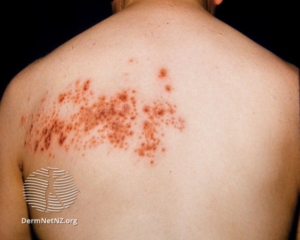Herpes zoster
Herpes zoster (also known as shingles) is a localized, blistering, and painful rash caused by reactivation of varicella-zoster virus (VZV) (as known as herpesvirus 3 member of the Herpesviruses). Herpes zoster is characterized by blisters that are confined to the cutaneous distribution of one or two adjacent sensory nerves, which are usually unilateral with a sharp cut-off at the anterior and posterior midlines.
the clinical presentation includes pain, which may be severe, relating to one or more sensory nerves. The patients usually feel quite unwell with fever and headache with the lymph nodes draining the affected area being enlarged and tender. The chest (thoracic), neck (cervical), forehead (ophthalmic), and lumbar/sacral sensory nerve supply regions are most commonly affected at all ages, with the frequency of ophthalmic herpes zoster increases with age. Anyone with previous varicella (chickenpox) may subsequently develop zoster. they may occur in childhood but are more common in adults, especially the elderly. After primary infection, VZV remains dormant in dorsal root ganglia nerve cells in the spine for many years before reactivating and migrating down sensory nerves to the skin causing herpes zoster. it’s still unknown why certain nerves are at higher risk, but the currently acknowledged trigger factors are: Pressure on the nerve roots, radiotherapy at the level of the affected nerve root and Spinal surgery. Common complications are: Involvement of several dermatomes or bilateral eruptions in unique dermatomes. Eye complications when the ophthalmic division of the fifth cranial nerve is involved. Deep blisters that destroy the skin. Muscle weakness in about one in 20 patients, with Facial nerve palsy being the most common result (Ramsey Hunt syndrome). Post-herpetic neuralgia is the persistence or recurrence of pain in the same area, more than a month after the onset of herpes zoster and It becomes increasingly common with age.
Antiviral treatment can reduce pain and the duration of symptoms if started within one to three days after the onset of herpes zoster. Because the risk of severe complications from herpes zoster is higher in older people, those aged over 60 years might consider the zoster vaccine, which can reduce the incidence of herpes zoster by half, and if they get herpes zoster despite being vaccinated, the symptoms are usually less severe and post-herpetic neuralgia is less likely to develop.
Written by: Bayan Alhazmi, Medical Student


Leave a Reply
Want to join the discussion?Feel free to contribute!